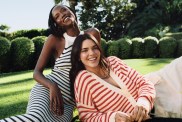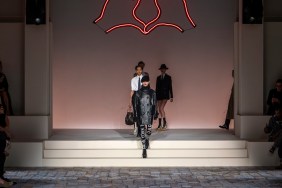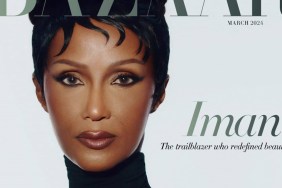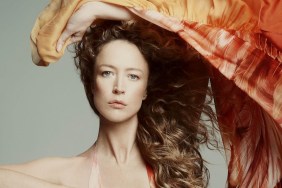The Fashion Spot: Many people follow fashion because they see fashion as art, or because they idolize models or love shopping. You say you are mainly interested in the cultural aspect of it. I think that’s one reason your posts are always so interesting to read, you bring in a different perspective. Do you think fashion and fashion magazines reflect the current state of our culture and society well?
Jemma: I do love fashion as an art form and because a garment is really pretty, but yes, the cultural aspect of it is highly fascinating to me. This is a tricky question to answer (but a really good one!) because fashion varies the world over. Here in America, I’d say that fashion and fashion magazines reflect the current state of our culture. Sometimes it feels like (at least in America) it’s not so much about the designs themselves but about who’s wearing these designs. The celebrity culture in America is pretty prominent so it’s not surprising that it also tends to pop up in fashion too. There are some celebrities, like the Olsens or Victoria Beckham, who I’d argue have managed to actually establish themselves as respected designers whereas others have not succeed in doing this.
There is always going to be a certain fascination with celebrities, and that’s okay, but it does seem like in the last 20 years it’s become more common for them to serve as a sort of link between the fashion world and average person. Which is why I do have to give Anna Wintour props, some may not like that she doesn’t really feature models on the covers anymore, but she saw a void which Vogue could fill by catering to the masses with celebrity covers. It was a pretty brilliant move on her part! And I know I’ve definitely appreciated her use of celebrities before (like Emma Watson’s or Meryl Streep’s covers). It’s this idea of identifying with actresses or musicians more easily than models that’s taken over many magazines. These celebrities are able to convey a sense of accessibility in order to provide a linkage between seemingly different worlds.
tFS: Does the fact that female models and celebrities are portrayed in such an over-sexualized way in fashion magazines and the fact that so many fashion shows and magazines still lack diversity affect the way you think about fashion? Does it make you enjoy fashion less or does it make it all the more interesting?
J: Even though there are all these issues, I still enjoy fashion, they just make me think more critically about what I’m viewing. I am one of those people always asking why — I just feel the need to understand the reasoning and supposed logic behind a decision. There is nothing wrong with being sexy but the extreme sexualization of women in advertisements and fashion magazines does worry me a bit. When you have photographers like Terry Richardson snapping pictures of women, these photographs are clearly by and for men, not for women. With a good number of female fashion photographers (Corrine Day, Cass Bird, Cindy Sherman, amongst others) I’ve noticed that when they portray a women in a sexy way, she’s in control of her own identity and sexuality. I don’t always see this in fashion photography by men. And since many fashion magazines and much of the industry is geared towards women, these sort of images can really mess with people’s minds. It can make women feel bad when they can’t match up to this sexy ideal, often it’s just not realistic, and I think that many women don’t understand this because it’s been shoved down our throats for so long. You start to internalize it, even if you know that these ideals aren’t realistic.
The lack of diversity in size, age and the ethnicities of women featured on the runway and in the pages of magazines is another place where I have a bone to pick. Personally, I am far more interested in seeing a women with interesting features and confidence in the pages of a magazine. It gets boring seeing the same types of models page after page. Plus, if women see other women who look a bit like them; women of all ages, ethnicities and sizes, it can only help to boost their confidence.
tFS: What do you think that we, as fashion fans, can do to make these things change and improve? What changes would you like to see?
J: This question reminds me of one of my favorite quotes (I hope you don’t mind me sharing it) by Ruth Benedict, which says, “The purpose of anthropology is to make the world safe for human differences.” And I would argue that fashion has a similar purpose. Fashion is fun and at times glamorous but, at least to me, it can also serve as a marker for how our society has progressed or regressed. I’d love to see more diversity in the magazines but not through “special issues” (like Vogue Italia is known for). While I’ve applauded such decisions in the past, I’ve started to realize that real change can only happen if editors include different types of models on the covers and in the magazines all the time. It can’t just be a special issue, because really in the long run, these editions don’t change anything. Personally, I also think that it’s important to continue to call out fashion designers, magazine editors and photographers for continuing to perpetuate certain standards.
If no one speaks out, then nothing will change. The wonderful thing is that now there are so many ways people can make their concerns known; here on tFS, Twitter, Facebook pages, there is a greater access to those working in the industry than ever before. So even people like me, who haven’t had a chance to work in the industry yet, can speak out and voice opinions and concerns.
tFS: What is your favorite era in the history of fashion?
J: The 1940s is a favorite of mine because I love how the changes in fashion reflect the changes in the social status of women. Especially during the war years, a great number of women entered the workforce and began championing American designers like Claire McCardell, in part because it became impossible to take inspiration from the Paris Couture Houses, many which shut down during WWII. It really changed the way America was viewed in regards to fashion and showed that these designers could be tastemakers too. Plus, in 1947, Dior’s New Look was introduced and it had a great impact on style and design. I think I also have a special fondness for this period because I love talking to my grandma about living through the war and serving in the armed forces as a WAC and hearing how style played a part of her daily life. It’s interesting to hear that even when cosmetics and fashion items were being rationed, like puffs for powder blush, women were able to make do and still look stylish. Even the simple things like washing her hair in her helmet on the beaches of France is quite telling of the era.
tFS: Which design houses do you think have the most interesting history and what makes them so fascinating?
J: One designer who I hold to high regard is Madame Gres. Her designs were beautiful and the backstory behind her brand is illuminating. Part of my fascination with Madame Gres has to be because of her sense of character. During WWII she was asked to design dresses for the wives of German officers but she refused to do so because she was Jewish. So they shut down her design house. She risked everything, it must have taken a lot of courage to say no, but she did. So while her label suffered during the war, her integrity did not. And I find that very admirable. But of course, it’s not just about the person behind the house but the clothes too, and my goodness were they gorgeous! I love how she made use of pleats and folds in her garments to create classic column gowns, which were influenced by her years as a sculptor.
tFS: What are some younger and newer designers that you love? Do you have any favorite recent collections?
J: I really enjoy seeing what Suno produces every season, I love how the label was founded using vintage Kenyan textiles. Suno is a brand that I feel like is able to beautifully incorporate local, traditional and high end techniques to their garments. Some designers take inspiration from a place for a season or two but with Suno it feels like they are not only taking inspiration from different locations but are invested in the places where the garments are being made (like Kenya, India and Peru). And I have a lot of respect for designers who make it part of their brand’s story to actively provide for those who are making the garments, it’s an ethical way of going about things. Besides Suno, I find Rachel Antonoff always has a beautiful presentation and collection of clothes. Her dresses just look like the sort of things that a girl could twirl about in. And of course more typical favorites include Rodarte and Alexander McQueen. The Mulleavy sisters, the late Alexander McQueen himself, and Sarah Burton have all created some stunning, thoughtful pieces. I appreciate how they create designs that make you think.
Alexander McQueen was a master at story-telling, his collections always made you feel something even if you weren’t quite sure what that was upon first viewing it. Plus, McQueen was able to take an aspect of a culture and make you feel uncomfortable and start to question things. And I think that sometimes being uncomfortable is an important part of fashion. Without that discomforting feeling, how can you ever get to the root of the issue: understanding why you are uncomfortable?
tFS: How did you find out about tFS?
J: I’ve been a member of tFS for just under three years, which seems really crazy now that I think about it! I can’t remember exactly how I found out about tFS, I think I was looking for information about fashion magazines online and tFS kept popping up. I’ll admit I sort of read the forums for a few months before becoming a member. I was just so pleased to have found a place online where like-minded people gathered because, while I have friends in real life who like clothes, I don’t really have any friends who are interested in the details like what goes on in the industry and the social and psychological aspects of fashion. I definitely enjoy thinking about how something which so many people deem “frivolous” can be a bellwether of change and can be explored to better understand a person or a society. (I guess this is the would-be anthropologist in me!)
tFS: What are your favorite threads or section of the tFS forums?
J: I really enjoy the magazines thread, it’s what drew me to tFS after all! But I also love reading the threads in Front Row’s Fashion…in Depth. There have been some really incredible conversations in this sub-forum and it’s one of the places I’ve turned to when I had questions about fashion on a greater scale, such as cultural appropriation and feminism and fashion. Those two topics are ones which I constantly struggle with in regards to understanding fashion (and myself). On perhaps a more lighthearted note, I also like spending time in the Star Style thread, it’s interesting to see what certain celebrities wear and how what they wear can be indicators of change within the fashion industry. Plus, sometimes I take inspirations from certain people for my own wardrobe. I find that the Entertainment Spot is a great place to really get to know other members and learn about other interests they have. I especially love the Movie Challenge thread, thanks to wonderful people in this thread I was motivated to watch over a hundred films last year!








